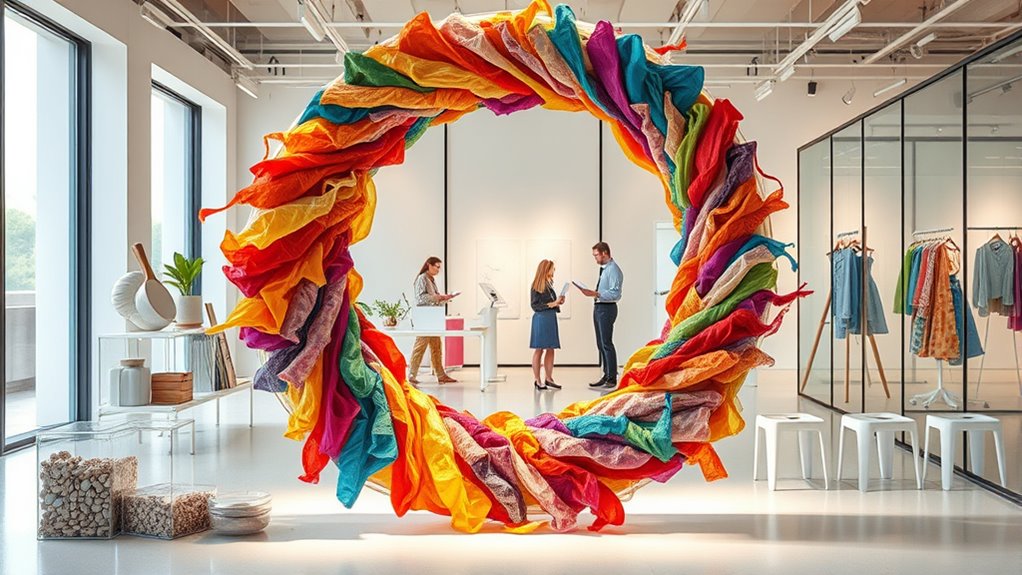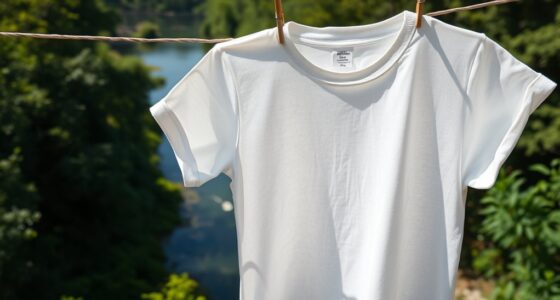Circular fashion uses closed-loop systems to keep clothing in use longer by recycling, reusing, and redesigning garments. When you return old clothes, they are broken down into raw materials and transformed into new fabrics, reducing waste and reliance on virgin resources. This sustainable process supports eco-friendly materials and designs for durability. By participating in these efforts, you help build a more responsible industry—if you want to understand how it all works, there’s more to explore.
Key Takeaways
- Closed-loop systems recycle garments into raw materials for new clothing, minimizing waste and resource use.
- Designing for recyclability and modularity enables garments to be easily disassembled and reused.
- Recycling processes break down textiles into fibers, supporting sustainable material production.
- Consumer participation, such as returning used clothing, is essential to sustain the circular cycle.
- The goal is to shift from landfill disposal to a regenerative, waste-free fashion industry.

Recycling processes play a crucial role here. They involve breaking down old textiles into raw materials that can be transformed into new fabrics. Advanced techniques allow for the recycling of different types of fibers, including cotton, polyester, and even blended fabrics. These processes help reduce the demand for virgin resources, which are often environmentally costly to extract and process. By recycling existing textiles, brands can markedly cut down on waste and lessen their environmental impact, creating a more sustainable supply chain. Additionally, awareness of divorce statistics highlights the importance of legal and emotional support systems during transitional periods.
Sustainable materials are another cornerstone of circular fashion. These include fabrics made from recycled fibers, organic cotton, hemp, and other eco-friendly options that are produced with minimal environmental harm. Using sustainable materials means that the raw inputs for clothing are renewable or recycled, which supports a more responsible approach to resource management. When combined with effective recycling processes, these materials help close the loop—turning used garments back into new, high-quality textiles instead of ending up in landfills.
Implementing a circular system requires more than just technology; it also involves designing clothes with their lifecycle in mind. Brands are now creating modular, repairable, and easily recyclable garments, knowing that consumers can return items at the end of their use. Once returned, these garments undergo recycling processes, where they are broken down and reprocessed into new materials, ready for another round of production. This cycle reduces waste, conserves resources, and supports a more sustainable fashion industry.
You, as a consumer, can support this system by choosing brands committed to circular practices, returning your clothing for recycling, or opting for products made from sustainable materials. Every step helps move the industry closer to a truly closed-loop model where waste becomes a thing of the past. Circular fashion isn’t just a trend; it’s a essential shift toward a more responsible and environmentally friendly future for apparel, driven by innovative recycling processes and sustainable materials that keep garments in use longer and waste out of landfills.
Frequently Asked Questions
What Are the Main Challenges in Implementing Closed-Loop Systems?
You face several challenges when implementing closed-loop systems. Supply chain integration can be complex, requiring coordination across multiple stakeholders. Consumer participation is essential, but convincing customers to return products or adopt sustainable habits isn’t easy. You also need to develop effective collection and recycling processes, which can be costly and technically demanding. Overcoming these hurdles demands effort, innovation, and collaboration to create truly sustainable, circular fashion systems that benefit everyone involved.
How Does Circular Fashion Impact Traditional Clothing Supply Chains?
You see that circular fashion impacts traditional clothing supply chains by shifting focus toward sustainable sourcing and extending product lifespan. Instead of just producing and disposing, supply chains adapt to reuse materials, reduce waste, and prioritize durability. This change encourages brands to rethink sourcing strategies, implement recycling processes, and create long-lasting products, ultimately making the entire system more eco-friendly and resilient, benefiting both the environment and consumers.
Can Small Brands Adopt Closed-Loop Practices Effectively?
Imagine your small brand weaving a vibrant, eco-friendly tapestry with supply chain integration and brand collaboration. You can adopt closed-loop practices effectively by forging strong partnerships with suppliers and recyclers, turning waste into new material. Small brands can innovate faster, ensuring sustainability is woven into every thread. With dedication, your brand can lead the way in circular fashion, proving that big change starts with collaborative, mindful steps.
What Materials Are Most Suitable for Closed-Loop Recycling?
When choosing materials for closed-loop recycling, you should focus on fibers with high durability and chemical compatibility. Natural fibers like cotton and wool often work well because they can withstand multiple cycles without losing quality. Synthetic fibers such as polyester and nylon are also suitable, as their chemical structure allows for easier recycling. Prioritizing these materials helps guarantee your closed-loop system remains efficient and sustainable, reducing waste and conserving resources effectively.
How Do Consumer Behaviors Influence Circular Fashion Success?
Your consumer participation and reuse habits play a vital role in the success of circular fashion. When you actively engage in recycling, reusing, and choosing sustainable brands, you help close the loop. Your behavior influences brands to adopt more eco-friendly practices and encourages others to follow suit. By making conscious choices and maintaining consistent reuse habits, you contribute considerably to building a sustainable, closed-loop fashion system that benefits the environment and the industry.
Conclusion
By embracing circular fashion, you become part of a vibrant cycle, turning waste into opportunity and fashion into a force for good. Imagine your choices as seeds, planting a greener future with every garment you love and reuse. When you join this closed-loop dance, you’re not just wearing clothes—you’re weaving a story of hope, sustainability, and transformation. Together, we can rewrite the fashion narrative into one that blooms endlessly, sustainable and beautiful.









